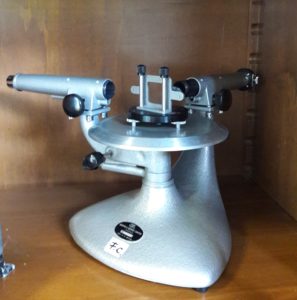
IT – Lo spettrometro a prisma, che deriva direttamente da quello proposto alla metà del 1800 dai fisici tedeschi G. R. Kirchhoff e R. W. Bunsen, permette di misurare spettri ottici utilizzando la scomposizione della luce nei colori dello spettro al passaggio attraverso un prisma. Esso è costituito da una base fissa sul cui bordo superiore è incisa una scala goniometrica. Un collimatore è solidale con la base mentre un cannocchiale è solidale con la piattaforma girevole. Una seconda piattaforma girevole costituisce la base di appoggio del prisma. Entrambe le piattaforme ruotano attorno allo stesso asse. Sulle due piattaforme sono incise due coppie di nonii diametralmente opposti che consentono la determinazione della posizione angolare sia del cannocchiale che della piattaforma con una precisione del primo di grado.
GB – Prism Spectrometer – The prism spectrometer, which derives directly from the one proposed in the mid-1800s by the German physicists G. R. Kirchhoff and R. W. Bunsen, allows to measure optical spectra using the decomposition of light in the colors of the spectrum when passing through a prism. It consists of a fixed base on whose upper edge a protractor scale is engraved. A collimator is integral with the base while a telescope is integral with the turntable. A second rotating platform forms the support base of the prism. Both platforms rotate around the same axis. Two pairs of diametrically opposed verniers are engraved on the two platforms, which allow the determination of the angular position of both the telescope and the platform with first degree precision.